Energy - Biomass
We yearn to grow and be free of our trappings. In terms of electricity and sustainability, we yearn to be free of the trappings of fossil fuels. We want to be able to look out at the world and know that we are either a shining light upon the Earth.
Our growth as a civilization depends, in part, upon our ability to generate electricity in the most efficient manner possible. It may not seem apparent at face value, but we are learning to be cleaner and pay attention to our surroundings.
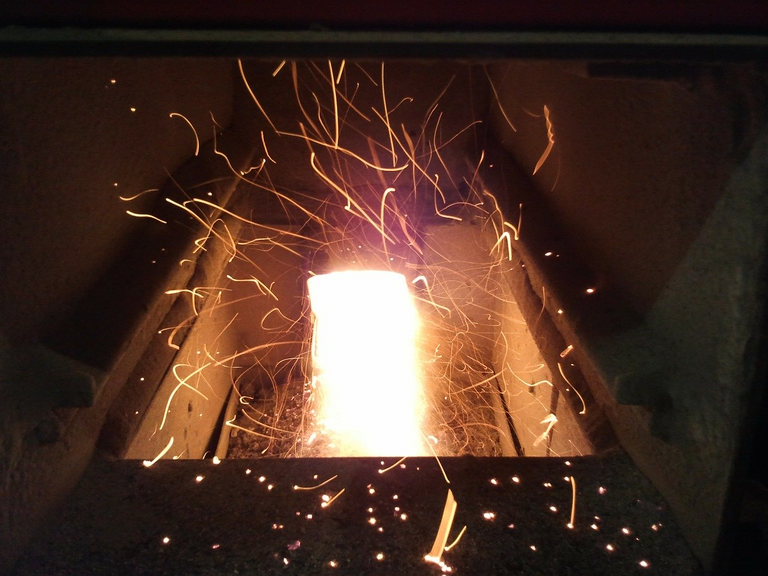
Image by Samuel Faber from Pixabay
Prologue

Futurism
Some realistic goals for energy development and production are a complete cradle-to-grave philosophy and comprehensive sustainability.
We strive to mine resources, produce electricity, and minimize environmental impact while we enjoy energy use. We want to reduce waste generation from the time we start mining the fuel until the time we remove waste created from production processes at a power plant. The concept was alien to us during our earlier days of power production. However, we are improving and, I believe, in a manner that will help the environment recover.
Our use of technology also allows us to utilize the waste products generated from day-to-day life. Nowadays, we can harness the power of industrial waste, animal manure, and plant life to power our world. Being able to utilize all endproducts of our daily activities instead of tossing them away to some unusable ending will further our progress towards being a Type I civilization.
Imagine, if you will, a future where we can reprocess animal, industrial, and agricultural wastes (and many more) for power production instead of being disposed of in massive landfills. Imagine a world where our waste products become another fuel source for productivity.
Introduction

Image by Robert Fotograf from Pixabay
Welcome, fellow Steemians, to our eighth installment in the Energy series. In this post, we will discuss the production of electricity through the use of biomass. Additionally, we will cover the effect of this process upon the environment, and much more! We did not address the topic of biomass energy in our first installment (Energy - Overview).
In our Energy series, we discussed how various forms of power production ultimately produce electricity. Coal, nuclear, concentrating solar, hydroelectric, and wind power plants product electricity similarly albeit with different sources of fuel. Biomass power is not too different except that here, the power of organic material is the driving source of power production.
What is Biomass Energy?

Image by an_photos from Pixabay
Biomass Energy represents the use of organic matter in a process for generating electricity or heat. Examples of organic matter include plants, crops, wood, solid waste, landfill or biogas, and even plastics!
Anything organic is a candidate for use in the process. However, depending on the method for power, some forms of organics may be preferable to others. For this article, we will focus on the use of biomass to generate electricity.
Biomass Power Generation
Brief history of biomass

Fandom - Greek Myth Wikia
The gifts and curses of fire, granted to us by fate or divinity, catapulted humanity from its more primitive origins. It's unknown, however, how we first created the power allowed us. More likely than not, we first learned to burn things like wood and, perhaps, even coal.
For the longest time, though, humans burned wood for their daily needs. We used firewood for everything, from cooking to building homes. Fast forward to the Industrial Revolution, and we find a need to feed the massive progress. Wood is still essential, but it is no longer enough.
Humanity, as we well know it, consumed more than it generated. Ultimately, our greed forced us to find another source of fuel, namely coal and oil (Eniscuola). We have since progressed to more powerful types of fuel to continue feeding our need for electricity. Slowly, but surely, however, we are learning to respect the land as our elders once did.
Basics of Biomass Power
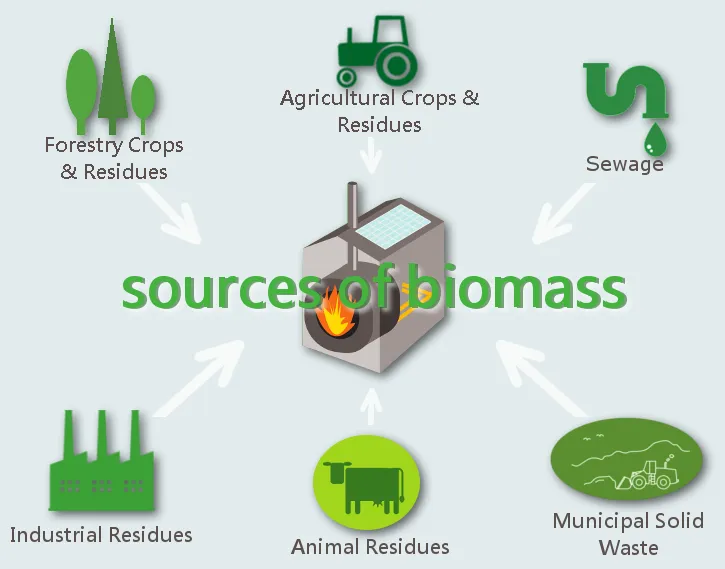
BioEnergy Consult
It starts with a source of organic matter. In the example provided above, we see that some sources of biomass include residues from forestry, industry, animals, city waste, or sewage (BioEnergy Consult).
We process the biomass and then feed it into a furnace where it aids us in producing work. In the case of electricity, the biomass aids in the generation of steam that rotates a turbine-generator to produce electricity (Energy-Overview). Let's discuss some specifics in how biomass can serve to either create electricity or supplement other processes to generate power without an increase in waste.
Before we begin, take a look at a video summary describing Biomass power and its importance in our energy cycle.
Video Summary
The above video provides an overall view of some biomass conversion processes.
Power Plant Demographics
Power Plant Types
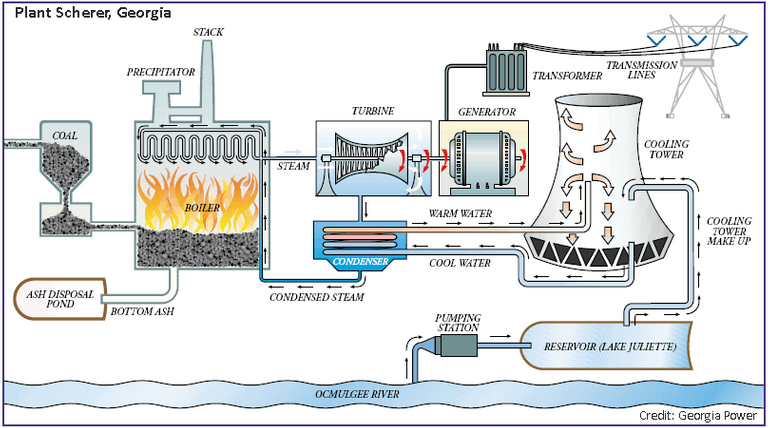
USGS - Plant Scherer, Georgia
Different forms of residue, or waste, must be handled differently to yield electricity or heat. However, some biomass processes are not sufficient enough to produce electricity at the scale of a city. Development of this technology is always in progress so, who knows what capabilities of this technology the future holds?
In commercial electrical power generation, the idea is to utilize the processing of biomass at an industrial level. Ultimately, the biomass used will aid in the creation of steam that rotates a turbine connected to an electrical generator. The rotating generator produces electricity and sends it via a transmission system to the end-user.
The processes listed below discusses the types of ways we convert biomass to generate power.
Gasification
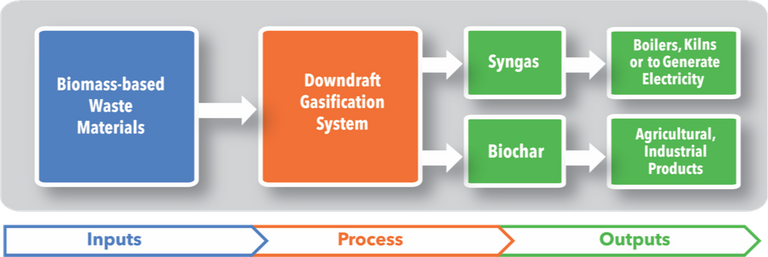
Aries Clean Energy
Gasification involves heating a variety of biomass forms into gases using heat and controlled supply of oxygen (SynTech Bioenergy). Some of the resultant gases produced includes hydrogen and methane, among others (SynTech Bioenergy).
The gases produced are directed towards a turbine to cause it to spin and rotate a generator that creates electricity. The result is not only a process that avoids the combustion cycle of a fuel source like coal, but it also significantly reduces the waste generated from other means. We are taking the "trash" we create and utilizing it as a primary fuel source. The process, however, isn't as simple as it seems.
The gasification process utilizes drying, pyrolysis, reduction, and combustion to create a medium sufficient to drive a turbine generator (SynTech Bioenergy). The goal is to remove water vapor from the biomass and to break it down into the gases needed, at high enough pressures, to operate the turbine.
Cofiring
Our earlier article, Energy-Coal, discussed the use of coal in commercial electricity generation. We wrote of how coal can pollute the environment and of methods proposed for making the process cleaner.
Coal Ash, one of the more hazardous constituents of coal power, can even be more radioactive than some forms of nuclear waste.
Biomass cofiring reduces the amount of pollution a coal power plant emits by replacing up to 15% of the coal utilized in the burning process with biomass (NREL). It seems obvious. If you use less fuel to create power, you get less pollution. It's easy to contemplate, but not so easy to implement.
Waste-to-Energy
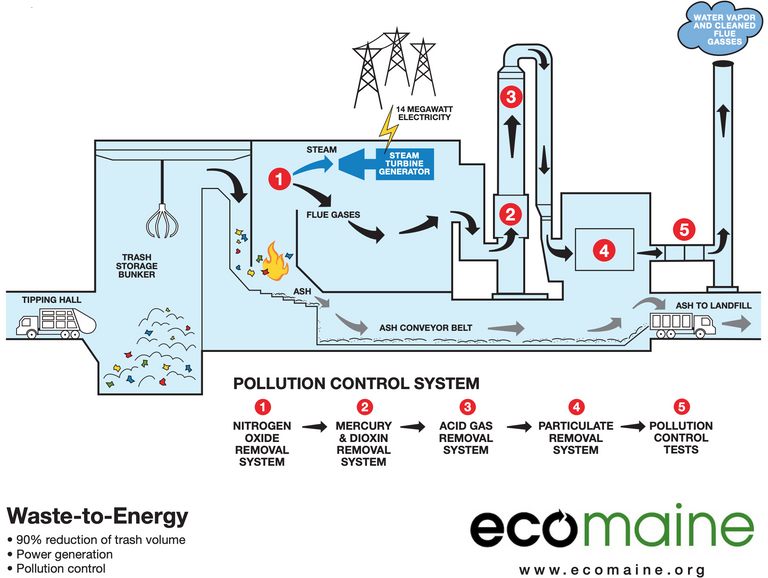
EcoMaine
Waste-to-Energy plants remove wastes from landfills and use it as a primary fuel source to produce electricity and heat. The use of this technology allows a reduction of trash volume up to 90% (EcoMaine).
The U.S. Energy Information Administration reports that waste-to-energy power plants, in 2019, burned approximately 34 million tons of garbage (EIA). In 2018, this process produced 14,000 gigawatt-hours of electricity (EIA).
Capacity/Locations
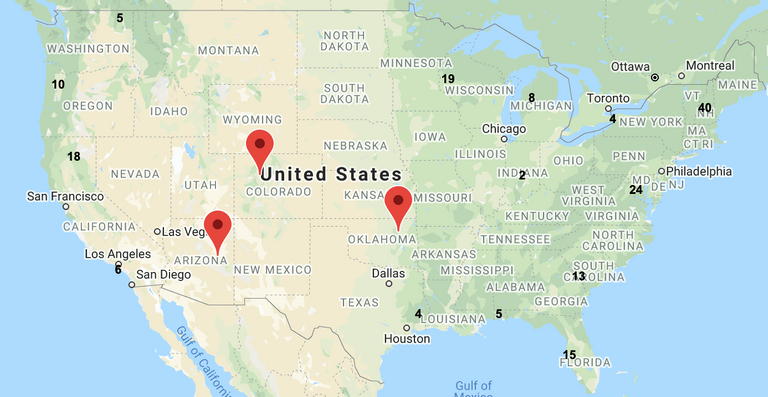
Biomass Magazine
The numbers vary across the internet concerning biomass power plants and whether they produce commercial electricity, heat, or some other service.
Biomass Magazine reports that, as of August 2019, the United States had 178 biomass power plants capable of delivering over 6 gigawatts of power combined. The map listed above shows the number of power plants located along with the different areas of the U.S. (Biomass Magazine).
Biomass Advantages

Image by Niek Verlaan from Pixabay
Biomass is everywhere

NREL
Whether it is a byproduct of a process, or you want to trash something, we can probably use it to create electricity or heat. Biomass is everywhere (NREL).
The image displayed in this section represents a resource map for solid biomass in the United States. If you check NREL's website, however, you will find resource maps for many other biomass-types (NREL). Over time, that list of resource maps will only become more extensive and more precise.
The importance is that there are almost no limits to what we can create, or utilize, as biomass.
Reduced Dependency

ThoughtCo
A goal for humanity is to eliminate any dependence on fossil fuels. We are doing that, albeit slowly.
The use of biomass in our energy cycle not only reduces our dependence on fossil fuels, but it also reduces the volume of wastes we eventually send to our landfills or discharge into the environment.
Reducing our dependence on fossil fuels reduces the likelihood that events like oil spill occur.
Manufacturing Revenue Source

Image by Gerd Altmann from Pixabay
We shouldn't let the concept of money and environmental protection mix, but we would be lying to ourselves if we said otherwise.
Money is a motivator, and with the added component of biomass, there is room to make some more. Manufacturer's aware of biomass power plants accepting of their wastes are more likely than not to utilize them aid the environment, as well as, their coffers. Is it a win-win?
Biomass Disadvantages

Image by Oberholster Venita from Pixabay
Cost of Manufacturing

Image by Andrew Khoroshavin from Pixabay
It is expensive to retrofit facilities that do not utilize biomass as a fuel source. Coal power plants that do not use biomass fuel sources, for instance, will have to spend a lot of money to upgrade their facilities (NREL). Depending on the plant's location, transportation costs will pace a considerable burden on operating expenses.
Another factor will be the biomass itself. Depending on what you're using, you may have to specially treat the fuel so that it can withstand the journey, storage, or preparations for processing. All-in-all, the use of biomass will depend on how the station can use it, store it, and recover costs from its use.
Lots of Space
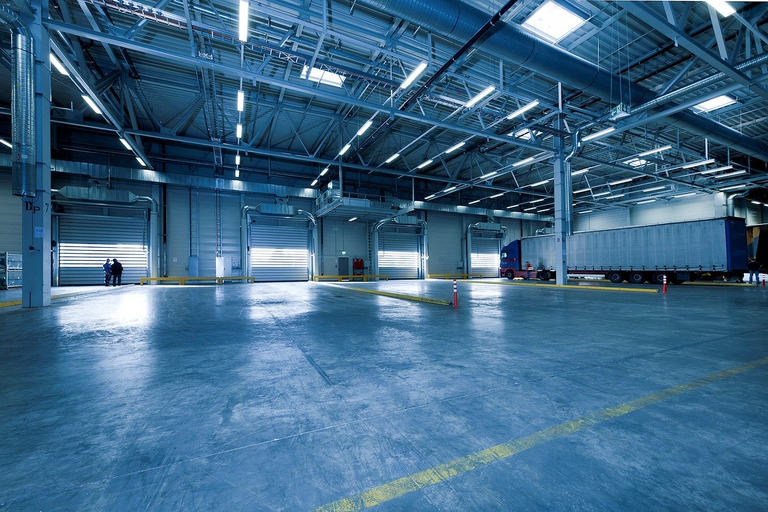
Image by EFAFLEX_Schnelllauftore from Pixabay
Some coal power plants can use up to 9,000 tons of coal per day (Energy Education). The coal supply has to come in via rail car and continually feed to standby areas of the plant.
You will also need areas to store large amounts of your selected biomass so as not to interrupt the combustion cycle of the power plant. I'm sure these facilities will have backup plans in the event biomass is not available, but these facilities are beasts. You need to feed them, and it's not wise to just arbitrarily stop a fuel cycle to switch fuel. Once you start the process, its safest to operate continuously; this means you will need to have enough space to store lots of biomass.
Resource Drains
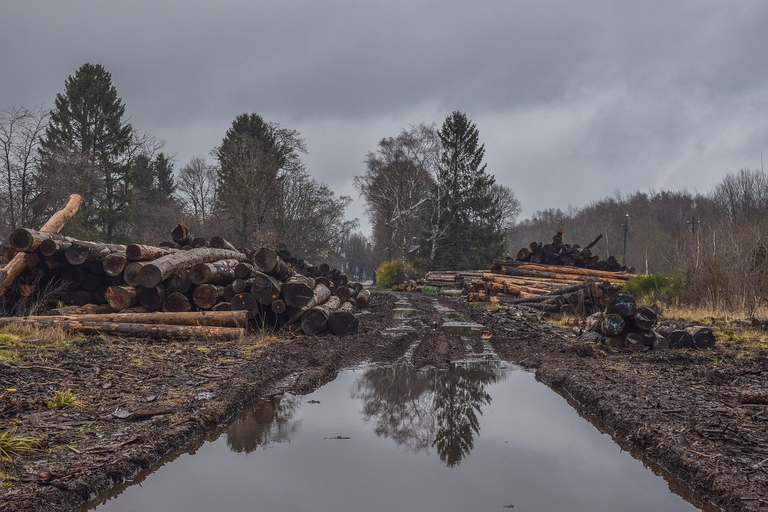
Image by Michael Gaida from Pixabay
New technologies usually deliver new problems before solving the original problem that created the latest technology. In the case of resource drains, the more common uses for biomass may generate a demand the environment can't meet. We need to be responsible individuals and ensure the use of biomass technologies don't needlessly create an unrecoverable resource.
In the use of wood, for instance, we want to take only what the land can offer. If we use up more trees, then we should plant enough ahead of time to compensate for what we use.
Technology Summary
It looks good, but is it?
Roads paved with good intentions look fantastic but lead to only one destination. One objective of this article was to provide an example of where reality did not reflect theory. The realist-approach here wasn't pessimistic. Instead, the intent was to show how an idea failed while recognizing that room for improvement exists. The argument represents a perfect idea. The practical application is entropy's way of saying we forgot to consider something.
Take, for instance, operations at Dominion Energy in Virginia. They purchased several biomass plants during a period where the government provided subsidies for the use of renewable energy. Great. One particle powerplant receiving such benefits was the coal fire cofire plant in Virginia City. Here, they use wood from trees as biomass fuel. Environmental groups point out that the forests once containing a particular tree are all cut down and replaced with differing trees for faster growth (Energy Central). The habitat is no longer the same.
According to some reports, cutting the use of biomass processes reduces the cost of their "clean energy" by two-thirds (Energy Central).
National Pollution Discharge Elimination System (NPDES) permits were not immediately available for this power plant at the time of this writing. Their claims of pollution are not validated at this time and could be subjective. I have seen articles on power plant activities where I've worked in the past that were unfounded, so there is a possibility that the plant operates within guidelines.
Technology of the Future
The concept of biomass power production is seductive. It has a solid foundation upon which we can complete our energy cycle. I'm not a fan of using forestry as fuel for power production. I'm confident, though, that we can all agree with recycling our trash as a means of producing our power.
In Closing

Thanks again, fellow Steemians, for following on with this series. Our next article will be on Natural Gas and covers similar topics as coal, nuclear, solar, hydro, and wind.
We are nearing the end of the energy series. It's been a great ride, and I've appreciated all the reviews and votes from the Steem and STEM Communities.
Each topic presented poses different challenges during research. It is essential to cite all available references for this work to ensure that all readers can validate the information presented as they desire. The goal, ultimately, is the dissemination of accurate and thoughtful information. Unfortunately, some topics are more difficult to research than others.





Great post! When will we collectively realize there IS no such thing as waste?? Biomass is a huge part of greener energy solutions.
Leading the curation trail for both @ecotrain & @eco-alex.
Together We’re Making This World A Better Place.
Click Here To Join the manually curated trail "@artemislives" to support quality eco-green content.
@artemisloves
Thank you for your response. I agree, which is why I believe the industry started using the term residue in industry discussions.
After this article I've learned you can produce power with pretty much anything. All it takes is the technology, resources, and effective means of pollution control.
”All it takes,” though, might take decades.
This post was shared in the Curation Collective Discord community for curators, and upvoted and resteemed by the @c-squared community account after manual review.
@c-squared runs a community witness. Please consider using one of your witness votes on us here
@c-squared
Thank you again for your support.
This post has been voted on by the SteemSTEM curation team and voting trail. It is elligible for support from @curie and @minnowbooster.
If you appreciate the work we are doing, then consider supporting our witness @stem.witness. Additional witness support to the curie witness would be appreciated as well.
For additional information please join us on the SteemSTEM discord and to get to know the rest of the community!
Thanks for having used the steemstem.io app and included @steemstem in the list of beneficiaries of this post. This granted you a stronger support from SteemSTEM.
@steemstem thank you for your support